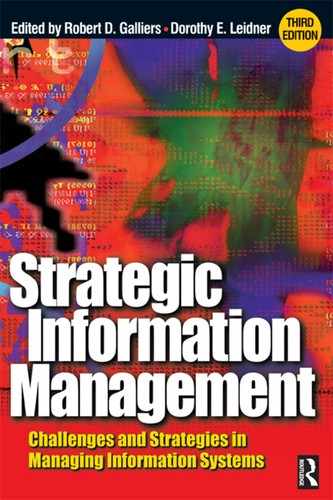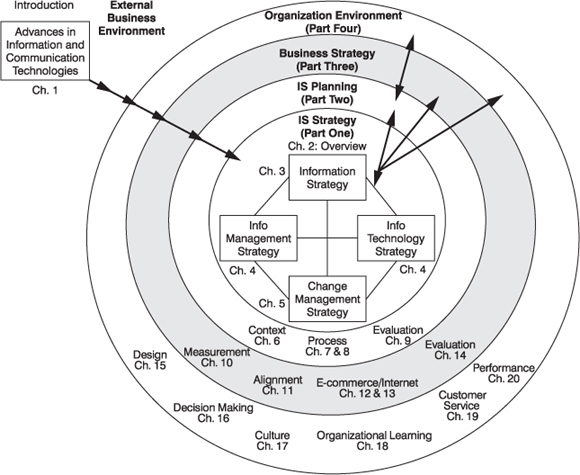Part Three
The Information Systems
Strategy–Business Strategy
Relationship
We now turn, in Parts Three and Four, to the contexts within which both information systems planning and information systems strategy take place. First, in Part Three, we consider the information systems strategy–business strategy relationship, while in Part Four we consider information systems strategy in the wider organizational environment. As can be seen from Figure III.1 (cf. the shaded portion of the diagram), our focus in Part Three is on aspects of the relationship itself (Chapters 10 and 11), on key strategic issues that have exercised minds in recent years, namely electronic commerce and the impact of the Internet (Chapters 12 and 13), and on the ever important issue of how to evaluate IS investment proposals.
Figure III.1 The focus of Part Three: the information systems strategy–business strategy relationship
In the first edition of Strategic Information Management we included an article by Clemons and Row (1991), which reflected the then state-of-the-art thinking on the attainment of competitive advantage from the astute utilization of information technology. This article was representative of many on this topic that appeared in the period from the mid-1980s through to the 1990s. The earlier articles focused on the issue of obtaining competitive advantage from IT (see, for example Ives and Learmonth, 1984; McFarlan, 1984; Cash and Konsynski, 1985; Porter and Millar 1985; Copeland and McKenney, 1988), while concerns in the latter part of the period were directed more towards sustaining that advantage (see, for example, Feeny and Ives, 1990, 1997; Mata et al., 1995). In the second edition of Strategic Information Management, we changed the focus somewhat by reflecting more of the thinking of the 1990s on this important topic. Now, with the third edition, we focus on recent thinking in relation to the important issues of alignment, eBusiness and IT evaluation. All but one of the articles appearing in Part Three are new to this edition.
We begin in Chapter 10 with an article by Reich and Benbasat that examines factors that influence alignment between business and IT objectives. Reich and Benbasat consider social alignment as a state in which business and IT executives have a shared understanding and commitment to the business and IT mission, objectives and plans. Using data gathered from ten business units in the Canadian life insurance industry, they looked at four factors: shared domain knowledge between business and IT executives; IT implementation success; communication between business and IT executives, and connections between business and IT planning processes. All these four factors influence short-term alignment whereas only shared domain knowledge appears to influence long-term alignment. Reich and Benbasat further our understanding of what alignment entails and what factors are important in obtaining alignment.
Whereas Reich and Benbasat focus on the question of what influences alignment, Sabherwal, Hirschheim and Goles in Chapter 11 focus on the question of how alignment is actually achieved. In contrast to the approach in Chapter 10, Chapter 11 employs a qualitative analysis of three case studies to highlight the value of a punctuated equilibrium model of alignment. They use the case studies to explain the way in which alignment evolves through modifications to an existing alignment pattern, punctuated by periodic transitions to a different alignment pattern. The transitions can be of an evolutionary or revolutionary character. Unlike prior research in the area of alignment, Sabherwal et al. find that evolutionary periods of organizational change may or may not entail a high level of alignment and that revolutionary change does not always increase alignment. The chapter helps to challenge one to consider the question of whether managers can exercise strong control over alignment, or whether in fact alignment can ever be achieved in an ever-changing organizational climate.
It is interesting to note that many organizations created separate eBusiness units, rather than housing eBusiness initiatives under the IT organization. This was done partly out of a concern that an eBusiness unit reporting through IT would be unable to achieve rapid response to the demands of the market. One wonders whether chief executives did not feel IT could truly meet their strategic agendas in the area of eBusiness. In other companies, IT played and continues to play a significant role in envisioning eBusiness strategies. Chapter 12 is an early article discussing electronic markets. By Lee and Clarke, this article offers many lessons on the conditions under which electronic markets will succeed. We believe this article provides lessons that are equally valuable today as when it first was published. This chapter provides us with an intriguing view of four cases where electronic market systems have been adopted: two successful, and two failed. Noting the potential of IT in reducing transaction costs and increasing market efficiency, the authors demonstrate how economic benefits from such adoptions can be achieved. Conversely, adoption barriers are also identified ‘by analyzing transaction risks and resistance resulting from reengineering’. As a result of this analysis, the authors claim that successful deployment of electronic markets and redesign of market processes using electronic commerce solutions is less about information technology per se, much more about understanding and managing the barriers and the projected economic benefits. For further classic readings on aspects of electronic commerce, see, for example, Rayport and Sviokla (1995); Benjamin and Wigand (1995), and Holland (1998). See also Elliott (2002).
Following Lee and Clarke's presentation of two eBusiness success stories and two failures, we include the article recently published in the Harvard Business Review wherein Porter presents his well-known five forces model of industry structure and his model of the value chain in the context of the Internet. He identifies areas where eBusiness might rightfully have major impacts on industry structures and on the organizational value chain. While the article might have been considered controversial had it been written several years earlier, few are likely to challenge the basic premises today: distorted market signals and the illusion of new rules of business led to gross exaggerations of the potential of the Internet to transform businesses, and to unwise investments. However, Porter does not argue that the eBusiness should be abandoned, but that companies should systematically consider eBusiness strategy in much the same way they develop organizational strategy, by carefully reflecting upon the current and future nature of their respective industries and by carefully examining the strengths and weaknesses in their own value chains, in order to identify those areas in which eBusiness has the potential to offer the organization important competitive returns.
While the eBusiness era gave the impression that many were investing in IT with little consideration for the ultimate outcome, as the pace of change seemed to demand rapid IT development and implementation, Chapter 14 offers a compelling example of how an organization can assess an IT proposal, even if the benefits are largely non-quantifiable. Irani and Love offer the story of a leading UK manufacturing organization during its adoption of a vendor-supplied Manufacturing Resource Planning (MRP) information system. Initially, led by a young, enthusiastic, but inexperienced management team, the company made an ‘act of faith’ decision to invest because they deemed the calculation of financial returns unachievable. The management team used a simplistic cost/benefit analysis where the perceived project costs and benefits were listed, but no attempt to assign financial values to these costs and benefits were made. Unfortunately for the team, the project ultimately ended in failure. Irani and Love caution against the argument that financial values cannot be assigned and counsel us not to make IT investments based solely on intuition.
References
Benjamin, R. I. and Wigand, A. (1995) Electronic markets and the virtual value chains on the Information Superhighway. Sloan Management Review, Winter.
Cash, Jr., J. I. and Konsynski, B. R. (1985) IS redraws competitive boundaries. Harvard Business Review, 63(2), March/April, 134–142.
Clemons, E. K. and Row, M. C. (1991) Sustaining Information Technology advantage: the role of structural differences. MIS Quarterly, 15(3), September, 275–292. Reproduced in Galliers, R. D. and Baker, B. S. H (1994), op cit., 167–192.
Copeland, D. G. and McKenney, J. L. (1988) Airline reservation systems: lessons from history. MIS Quarterly, 12(3), September, 353–370.
Elliott, S. (ed.) (2002) Electronic Commerce: B2C Strategies and Models, Wiley, Chichester.
Feeny, D. F. and Ives, B. (1990) In search of sustainability: reaping long-term advantage from investments in Information Technology. Journal of Management Information Systems, 7(1), Summer.
Feeny, D. F. and Ives, B. (1997) IT as a basis for sustainable competitive advantage. In Willcocks, L. et al. (1997), op cit., 43–63.
Feeny, D. F. Edwards, B. and Simpson, K. (1992) Understanding the CEO/CIO relationship. MIS Quarterly, 16(4), 435–448.
Holland, C. (ed.) (1998) Special Issue of the Journal of Strategic Information Systems on Electronic Commerce, 7(3), September.
Ives, B. and Learmonth, G. P. (1984) Information Systems as a competitive weapon. Communications of the ACM, 27(12), December, 1193–1201.
McFarlan, F. W. (1984) Information technology changes the way you compete. Harvard Business Review, 62(3), May/June, 98–102.
Mata, F. J., Fuerst, W. L. and Barney, J. B. (1995) Information Technology and sustained competitive advantage: a resource-based analysis. MIS Quarterly, 19(4), December, 487–505.
Porter, M. and Millar, V. E. (1985) How information gives you competitive advantage. Harvard Business Review, 63(4), July/August, 149–160.
Rayport, J. F. and Sviokla, J. J. (1995) Exploiting the virtual value chain. Harvard Business Review, 73(6), November/December, 75–85.
Willcocks, L., Feeny, D. and Islei, G. (1997) Managing IT as a Strategic Resource, McGraw Hill, London.

